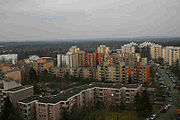
Langwasser
Encyclopedia
Langwasser is a district of Nuremberg
in the southeastern area of the city. It was developed as a prototype of the satellite town concept in the 1960s and is primarily a suburban residential area. The name Langwasser (translated as "long water") comes from a small stream bordering the area on its eastern edge.
. After devastating forest fires between 1917 and 1919 the area was cleared and used for farming.
, the area which had been cleared by fire became an important site for the Nazi movement. Beginning in 1934 it was the site of various tent cities and encampments. The area originally housed a tent encampment of the Reich Labor Service (RAD) and later the Hitler Youth
(HJ). Permanent camps for the SS, SA, HJ, and RAD were built near the Nuremberg Rally Grounds. The Langwasser camp, with space for 200,000, was the largest. At the outbreak of World War II, party rallies ceased and the compound was converted into a POW camp known as Stalag
13 which housed up to 150,000 prisoners until closing in 1940. In this camp during August 1940, prisoners of war celebrated a "special Olympics" called International Prisoner-of-War Olympic Games where prisioners of Belgium, France, Great Britain, Norway, Poland, Russia and Yugoslavia took part. United States military records report that 6,676 American POWs were transferred there late in the war.

 Langwasser is served by the U-Bahn (subway / underground train). Langwasser Süd is a Nuremberg U-Bahn
Langwasser is served by the U-Bahn (subway / underground train). Langwasser Süd is a Nuremberg U-Bahn
station, located on the U1 and U11 lines.
Nuremberg
Nuremberg[p] is a city in the German state of Bavaria, in the administrative region of Middle Franconia. Situated on the Pegnitz river and the Rhine–Main–Danube Canal, it is located about north of Munich and is Franconia's largest city. The population is 505,664...
in the southeastern area of the city. It was developed as a prototype of the satellite town concept in the 1960s and is primarily a suburban residential area. The name Langwasser (translated as "long water") comes from a small stream bordering the area on its eastern edge.
History
At the beginning of the 20th Century the area that would become Langwasser was heavily wooded and part of the Imperial ForestReichswald
A Reichswald designates a historic woodland under imperial protection and usage in the lands of the former Holy Roman Empire. It may refer to:* Nürnberger Reichswald — an old cultivated forest with near Nuremberg, which is today a nature reserve....
. After devastating forest fires between 1917 and 1919 the area was cleared and used for farming.
The Nazi Era
Prior to World War IIWorld War II
World War II, or the Second World War , was a global conflict lasting from 1939 to 1945, involving most of the world's nations—including all of the great powers—eventually forming two opposing military alliances: the Allies and the Axis...
, the area which had been cleared by fire became an important site for the Nazi movement. Beginning in 1934 it was the site of various tent cities and encampments. The area originally housed a tent encampment of the Reich Labor Service (RAD) and later the Hitler Youth
Hitler Youth
The Hitler Youth was a paramilitary organization of the Nazi Party. It existed from 1922 to 1945. The HJ was the second oldest paramilitary Nazi group, founded one year after its adult counterpart, the Sturmabteilung...
(HJ). Permanent camps for the SS, SA, HJ, and RAD were built near the Nuremberg Rally Grounds. The Langwasser camp, with space for 200,000, was the largest. At the outbreak of World War II, party rallies ceased and the compound was converted into a POW camp known as Stalag
Stalag
In Germany, stalag was a term used for prisoner-of-war camps. Stalag is a contraction of "Stammlager", itself short for Kriegsgefangenen-Mannschafts-Stammlager.- Legal definitions :...
13 which housed up to 150,000 prisoners until closing in 1940. In this camp during August 1940, prisoners of war celebrated a "special Olympics" called International Prisoner-of-War Olympic Games where prisioners of Belgium, France, Great Britain, Norway, Poland, Russia and Yugoslavia took part. United States military records report that 6,676 American POWs were transferred there late in the war.
The Post-War Period
The actual history of Langwasser as a district begins after the Second World War in 1949. For ten years the area was a mixture of refugee camps and temporary housing developments. Construction of the first permanent housing developments did not begin until the 1950s. Many German refugees from Silesia and from the Sudetenland made Langwasser their new home.Modern Times
The modern history of Langwasser begins with the decision of the city of Nuremberg to develop a planned community in the area marketed with the slogan "living in the country". An architectural competition was held in 1956 with construction beginning the following year. Construction was not fully completed until the 1990s.Architecture


Nuremberg U-Bahn
The Nuremberg U-Bahn is a metro run by VAG Nürnberg , which itself is a member of the VGN . The Nuremberg U-Bahn is Germany's newest metro...
station, located on the U1 and U11 lines.

